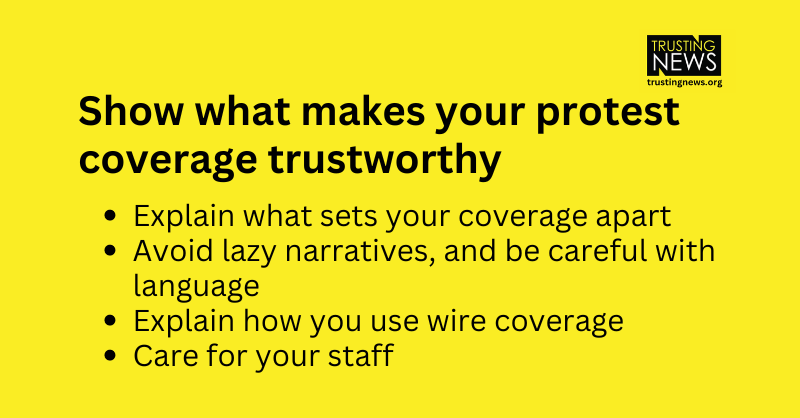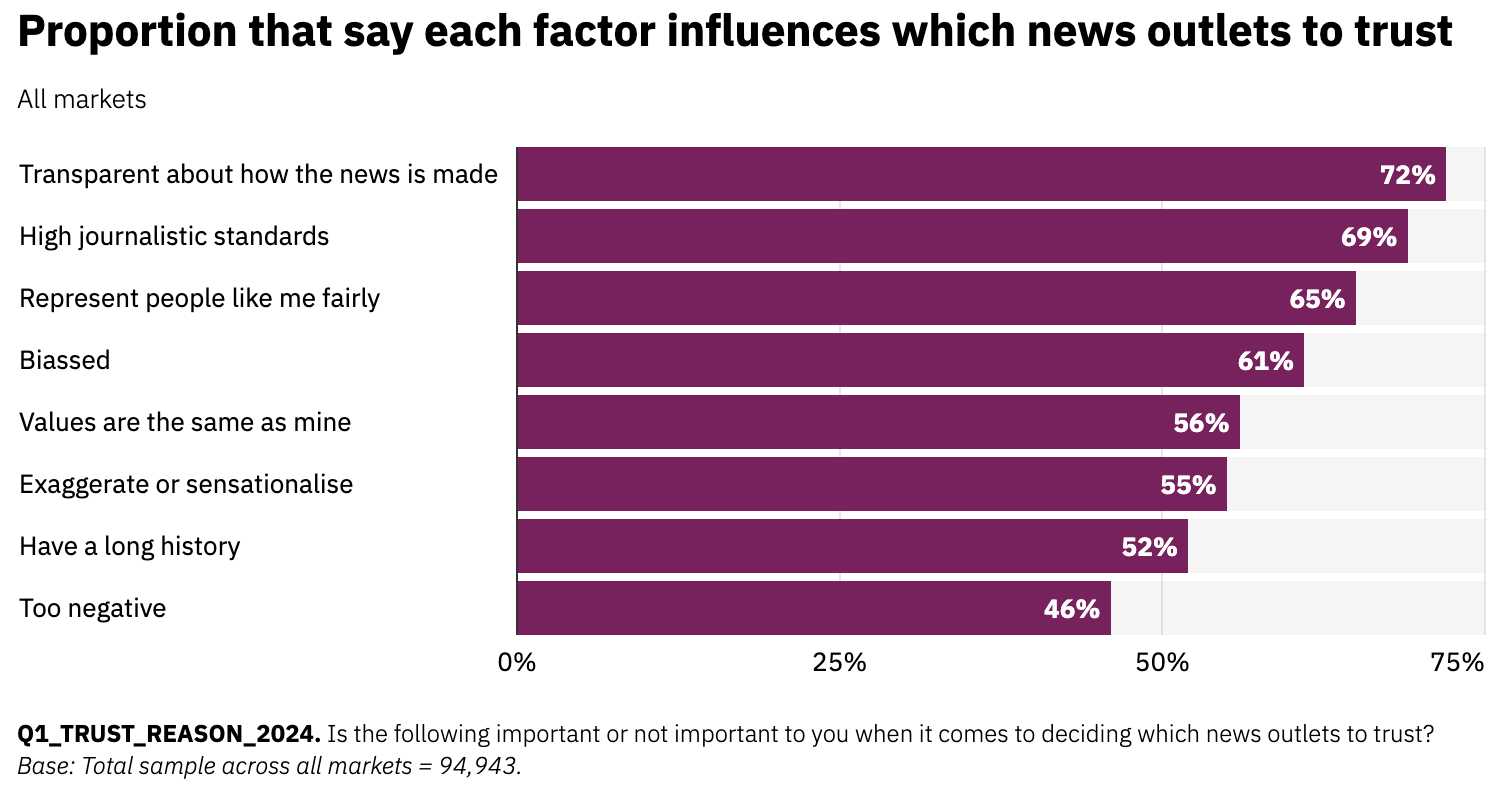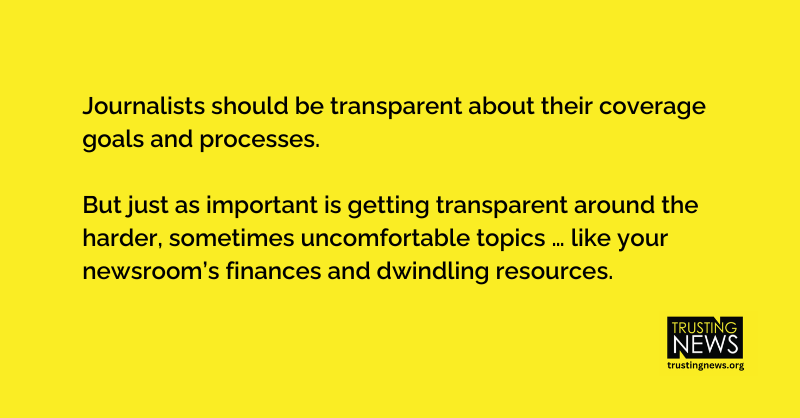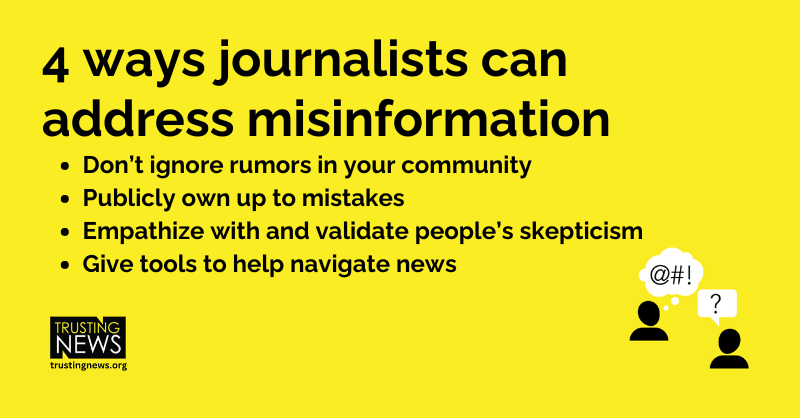
Prioritize transparency in coverage of encampments, protests
We know covering the recent protests hasn’t been easy for journalists.
Many newsrooms are trying to be accurate and fair while providing nuanced and complex coverage of what’s happening. It’s almost guaranteed some people will disagree with your reporting or see the headline, make a judgment that the story is biased and skip it altogether.
As journalists, getting transparent about how you’re working to be fair and factual is always important, but it’s especially important when it comes to topics that elicit a lot of emotion and invite heightened public scrutiny. Whether your newsroom is providing local coverage, sharing wire coverage from other outlets, or a mixture of both, it’s important to explain what sets your coverage apart in a crowded media landscape full of sources providing a mixed bag of coverage.
As tensions surrounding pro-Palestinian protests and encampments across the country remain high, we wanted to use today’s newsletter as an opportunity to refresh some advice and strategies we’ve given newsrooms on how they can work to show what makes their protest coverage trustworthy and credible.
Reminder: At Trusting News we want to help journalists make decisions based on their own values and their audience’s needs. We are not here to tell you what specific stories to publish, or what specific words you should use. Rather, we aim to help you be consistent, thoughtful and transparent about your coverage decisions.
Explain what sets your coverage apart
Colleen Murphy at Open Campus wrote a great piece about what journalists tend to get wrong in protest coverage, and the importance of journalists really knowing their communities. As Murphy writes, this is true of student media covering the encampment on many college campuses, as well as local journalists who understand the context of a place. No matter what expertise or unique angle you offer, we suggest you continually remind your audience of what sets your coverage apart. Explain what you’re being intentional about. Share why you’re equipped to get this story right. (We write more about how to do that with protest coverage here.)
We also would highly recommend local newsrooms collaborate with student media who understand the context and situation and likely have been doing even more on-the-ground reporting.
Avoid lazy narratives, and be careful with language
Make sure you’re working to reduce stereotypes and assumptions in your reporting. Avoid making sweeping generalizations or labeling large groups of people. Get specific, and continually check your bias, especially when it comes to word choice. Research shows the words journalists use while covering a protest can alter the public’s perception of the event. Think about why you might choose active or passive voice. This can be especially important in headlines and in social media chatter where stories or videos often appear with little context. Our Anti-Polarization checklist can help.
Explain how you use wire coverage
If wire coverage is part of the content you offer your audience, you’re being held responsible for it (yes, even if it’s not your reporting!). Start by explaining that you use wire content, why you use it, and why you trust these other sources to provide accurate coverage.
Also, we encourage newsrooms to take the extra step to carefully edit wire stories and headlines, especially if you feel like they might contain problematic framing or bias. Check headlines to make sure they reflect a fair perspective and are straightforward (not catchy or adding to the shock value). Too often, straightforward, responsible stories get misrepresented by the frame of a headline.
Trust and care for your staff
You’ve maybe heard from journalists or seen social media posts sharing the challenges of covering this conflict while grappling with the weight of it in their daily lives. Whether you have journalists in your newsroom who can identify with that or not, your staff likely has a lot of their own feelings about what’s happening.
As with any tough coverage, you can earn the trust of your colleagues by honoring their experiences and giving them room to navigate how those factors influence their coverage. Rather than trying to ignore lived experience, turn it into a conversation. Discuss it honestly and together talk through how they should and shouldn’t show up in our coverage decisions. (Our Dimensions of Difference guide has more guidance on how to do this.)
And, most importantly, if you’re a leader in the newsroom, regularly check in on your staff’s capacity and emotional well-being.
Additional resources
- Assistant Director Lynn Walsh wrote a newsletter a few months back with tips for how journalists can cover conflict and war, with a helpful example of how Outlier Media explained their coverage goals and how they are prioritizing covering local impact.
- In a past post about taking care with your coverage of police violence and protests, Director Joy Mayer shared tips about the importance of diving into complexity and being cautious about who is treated as an independent authority in your stories. A lot of this can be applied to your coverage of these protests.
At Trusting News, we learn how people decide what news to trust and turn that knowledge into actionable strategies for journalists. We train and empower journalists to take responsibility for demonstrating credibility and actively earning trust through transparency and engagement. Subscribe to our Trust Tips newsletter. Follow us on Twitter and Facebook. Read more about our work at TrustingNews.org.

Project manager Mollie Muchna (she/her) has spent the last 10 years working in audience and engagement journalism in local newsrooms across the Southwest. She lives in Tucson, Arizona, where she is also an adjunct professor at the University of Arizona’s School of Journalism. She can be reached at mollie@trustingnews.org and on Twitter @molliemuchna.





